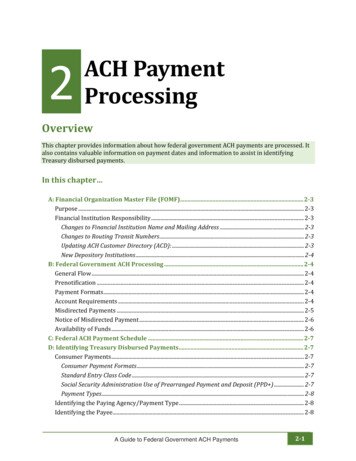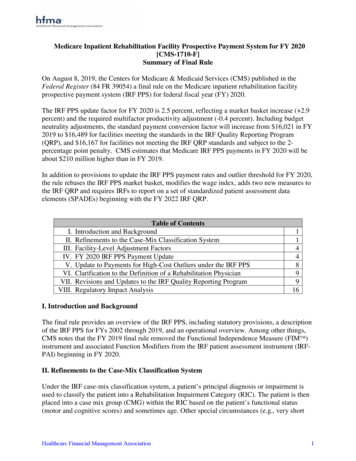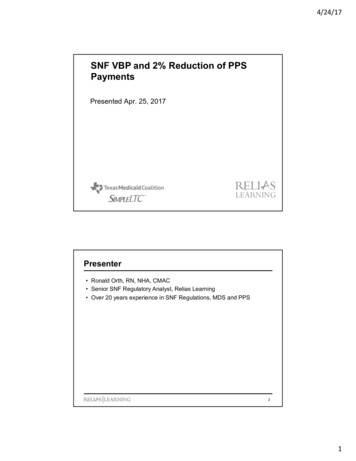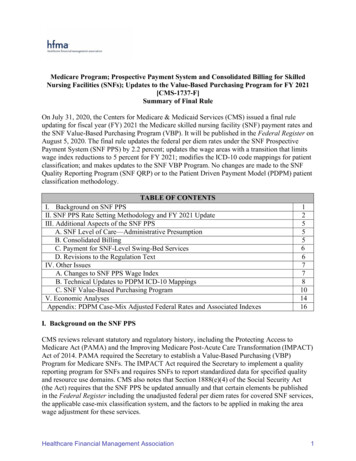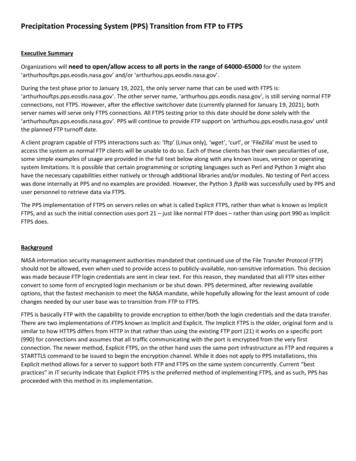
Transcription
Precipitation Processing System (PPS) Transition from FTP to FTPSExecutive SummaryOrganizations will need to open/allow access to all ports in the range of 64000-65000 for the system‘arthurhouftps.pps.eosdis.nasa.gov’ and/or ‘arthurhou.pps.eosdis.nasa.gov’.During the test phase prior to January 19, 2021, the only server name that can be used with FTPS is:‘arthurhouftps.pps.eosdis.nasa.gov’. The other server name, ‘arthurhou.pps.eosdis.nasa.gov’, is still serving normal FTPconnections, not FTPS. However, after the effective switchover date (currently planned for January 19, 2021), bothserver names will serve only FTPS connections. All FTPS testing prior to this date should be done solely with the‘arthurhouftps.pps.eosdis.nasa.gov’. PPS will continue to provide FTP support on 'arthurhou.pps.eosdis.nasa.gov' untilthe planned FTP turnoff date.A client program capable of FTPS interactions such as: ‘lftp’ (Linux only), ‘wget’, ‘curl’, or ‘FileZilla’ must be used toaccess the system as normal FTP clients will be unable to do so. Each of these clients has their own peculiarities of use,some simple examples of usage are provided in the full text below along with any known issues, version or operatingsystem limitations. It is possible that certain programming or scripting languages such as Perl and Python 3 might alsohave the necessary capabilities either natively or through additional libraries and/or modules. No testing of Perl accesswas done internally at PPS and no examples are provided. However, the Python 3 ftplib was successfully used by PPS anduser personnel to retrieve data via FTPS.The PPS implementation of FTPS on servers relies on what is called Explicit FTPS, rather than what is known as ImplicitFTPS, and as such the initial connection uses port 21 – just like normal FTP does – rather than using port 990 as ImplicitFTPS does.BackgroundNASA information security management authorities mandated that continued use of the File Transfer Protocol (FTP)should not be allowed, even when used to provide access to publicly-available, non-sensitive information. This decisionwas made because FTP login credentials are sent in clear text. For this reason, they mandated that all FTP sites eitherconvert to some form of encrypted login mechanism or be shut down. PPS determined, after reviewing availableoptions, that the fastest mechanism to meet the NASA mandate, while hopefully allowing for the least amount of codechanges needed by our user base was to transition from FTP to FTPS.FTPS is basically FTP with the capability to provide encryption to either/both the login credentials and the data transfer.There are two implementations of FTPS known as Implicit and Explicit. The Implicit FTPS is the older, original form and issimilar to how HTTPS differs from HTTP in that rather than using the existing FTP port (21) it works on a specific port(990) for connections and assumes that all traffic communicating with the port is encrypted from the very firstconnection. The newer method, Explicit FTPS, on the other hand uses the same port infrastructure as FTP and requires aSTARTTLS command to be issued to begin the encryption channel. While it does not apply to PPS installations, thisExplicit method allows for a server to support both FTP and FTPS on the same system concurrently. Current “bestpractices” in IT security indicate that Explicit FTPS is the preferred method of implementing FTPS, and as such, PPS hasproceeded with this method in its implementation.
Encrypted Connected Lag IssuesUnfortunately, the imposition of encryption onto an FTP connection produces a noticeable lag. On interactiveconnections, the lag is usually only noticeable on the initial connection, while subsequent commands tend to becompleted quickly. However, when operations are conducted as a series of independent connections, as is often thecase with scripted retrievals, the lag applies to each connection individually. The internal tests conducted by PPS showthat this lag time is usually in the 10-20 second range.FTP(S) Data Port IssuesThe existing, original PPS FTP servers have always used a limited range of ports (64000-65000) for data connections afterinitial connection has been made. This has never had any impact on users’ ability to connect because the negotiationsequence wherein the port is promulgated from server to client have been conducted in clear text. This clear textexchange of the next port to be used for data transfers allowed firewalls conducting stateful packet inspection (SPI) tobe able to determine that a subsequent connection to port N was in fact related to a previously allowed connection andthus could proceed. Unfortunately, the requirement to encrypt the login exchange means that this information can nolonger be gleaned by the firewalls because it is no longer visible to them. Therefore, firewalls no longer see the initialconnection and the follow-up connection to be ‘related’ and many, due to their own security settings, deny the dataconnection from proceeding, thus blocking access. In essence, this is one security system petulantly denying furtheraccess because another security system required encryption to be used, and now the first system isn’t able to eavesdropand figure out what’s going on.So, while PPS hasn’t changed how the data ports work, or what sequence of ports is used, many users suddenly findthemselves unable to access the server because their own firewalls are blocking the connections. The easiest, and moststraight-forward, way to deal with this issue is for users to implement (or have their IT departments implement,depending on institutional size and requirements) a firewall rule that allows access to all ports in the range of 6400065000 for the DNS names of: ‘arthurhou.pps.eosdis.nasa.gov’ and ‘arthurhouftps.pps.eosdis.nasa.gov’. Doing this willensure that connections can successfully work.FTPS Client ExamplesThe following list is not meant to be exhaustive; these are simply the client programs that PPS used to test FTPS accessto its server. The client programs have extensive option sets that PPS has not explored or provided documentationabout, users are encouraged to investigate these options themselves as their need and desires determine.lftp (Linux)The ‘lftp’ program was tested for manual FTPS connections, although the program does provide options for executingscripted connections, no example of this type is provided.Example:lftp arthurhouftps.pps.eosdis.nasa.gov -u [user name],[password]Notes: The ‘lftp’ program needs to be fairly recent. We found during investigations that the ‘lftp’ client in use onRedhat Enterprise Linux (RHEL) 6 systems (and its clones such as CentOS) did not have the required built-in securitylibraries necessary to interact with the FTPS server. However, RHEL 7 and RHEL 8 systems (and their clones) do not havethis issue and were able to successfully connect.
curlThe ‘curl’ program was tested for directory listing and file download. Curl is available on Linux, Mac and Windows.However, Windows and Mac users will need to download the appropriate package. Generally, in Linux distributions, curlis part of the distribution. All examples below are meant to be a single line, but due to line-wrapping in this document,they have been broken apart across multiple lines.Example:Directory Listing:curl -4 –-ftp-ssl –-user [user a.gov/gpmdata/documents/File Retrieval:curl -4 –-ftp-ssl –-user [user a.gov/gpmdata/documents/TMPA IMERG comparison.pdf -oTMPA IMERG comparison.pdfNotes: The ‘curl’ program was the only one tested which was found to work across all three current versions ofRedhat Enterprise Linux (RHEL) (and clone) systems, 6x, 7x, and 8x. Note that in the example above we have forced useof the Internet Protocol version 4 (IPV4) which may be necessary depending on how your system is provisioned. Wehave noticed that some systems have ‘default’ Internet Protocol Version 6 (IPV6) addresses set but which are not set upcorrectly; yet the system uses this IPV6 address regardless and thus return connection attempts are lost. The PPS FTPSserver is set up to correctly handle IPV6 connections but requires that IPV6 be set up correctly on the client end as well.If you’re sure that: 1) IPV6 is correctly setup on your system, or 2) IPV6 is not set up at all on your system, you may omitthe ‘-4’ from the examples above.wgetThe ‘wget’ example is provided only for file download and not for directory listing. Although directory listing, would bepossible, it would require the resultant output to be ‘scraped’ to determine what the directory structures and filesavailable were. Wget is available for Linux, Mac, and Windows. Generally, it is included in Linux distributions but must bedownloaded for Windows and Mac. Wget allows the protocol type FTPS to be listed as part of the URI, unlike curl, whichspecifies FTPS rather than FTP through command-line arguments. Wget also provides a simpler syntax for retrieving fileslisted in a list provided to the command. Note that wget may not work properly with Redhat version 6, 7, or theirderivatives (e.g. CentOS).The example below is meant to be a single line, but due to line-wrapping in this document, it has been broken apartacross multiple lines.Example:wget -4 –-ftp-user [user name] –-ftp-password [password] /documents/TMPA IMERG comparison.pdfNotes: As in the examples for ‘curl’ above, we have forced use of the Internet Protocol version 4 (IPV4) whichmay be necessary depending on how your system is provisioned. We have noticed that some systems have ‘default’Internet Protocol Version 6 (IPV6) addresses set but which are not set up correctly and yet the system uses this IPV6address regardless and thus return connection attempts are lost. The PPS FTPS server is set up to correctly handle IPV6connections but requires that IPV6 be set up correctly on the client end as well. If you’re sure that 1.) IPV6 is correctlyset up on your system, or b.) IPV6 is not set up at all on your system, you may omit the ‘-4’ from the examples above.Also note that the -O option names the downloaded file with the same name as the remote file.
FileZillaWe have successfully tested the graphical FileZilla client from Windows 10, CentOS (RHEL clone) version 7, and macOSBig Sur and Catalina. Currently, there is no version of FileZilla available for RHEL version 8 and the version on RHELversion 6 does not have the updated security libraries necessary to connect. The details of using FileZilla can be found inthe FileZilla documentation and may change in various versions of FileZilla, but the basic steps are as follows. Select theFile Site Manager menu option. Click on New Site to set up a connection. Type "PPS Production Archive" or somethingsimilar in the Name field, and arthurhouftps.pps.eosdis.nasa.gov in the Host field. Leave the Port field blank. ForEncryption, select "Use explicit TLS over FTP if available," and leave Logon Type as "Normal". In both the User andPassword fields, enter the email address that you have previously registered with PPS. istration/ to register.) Last, click Connect.TimelineCurrently normal FTP operations are being provided via the ‘arthurhou.pps.eosdis.nasa.gov’ server and FTPS operationsprovided by the ‘arthurhouftps.pps.eosdis.nasa.gov’ server. On date: 19 January 2021, all normal FTP operations willcease, and only FTPS connections will be allowed. At that time both server addresses, i.e., ‘arthurhou’ and‘arthurhouftps’, will provide FTPS access. At that time, however, they will cease to be separate systems and will insteadbe collocated on a single host server. PPS will be maintaining the ‘arthurhouftps.pps.eosdis.nasa.gov’ server out ofcourtesy for those users who change over to FTPS earlier and do not wish to go back and modify their code to use the‘arthurhou’ name again.STORM OrdersSTORM provides options to receive scripts to assist in retrieving ordered data via FTPS. Three options are available, thefirst of which is recommended for reasons described below: Python script FTPS script FTPS URLThe Python script is run with the Python 3 interpreter:python script.pyThe Python script hides the details of the file transfer from the user. It attempts to connect to the PPS FTPS server butwill fall back to the HTTPS server if needed. It will also perform ‘sha’ hash tests against downloaded data files to confirmtheir contents. The script will skip over files that have already been downloaded, which allows the scripts to be stoppedand started again later. Due to these benefits, the Python script is the recommended method of obtaining data fromPPS.The FTPS script is meant to use used with lftp on Linux / maclftp scriptThe FTPS url file can be directly used with wgetwget -i urlfileUnfortunately, curl cannot use FTPS URLs. To convert the PPS FTPS URL file to FTP URLs, run (on Linux/mac)sed -i 's/ftps:/ftp:/g' urlfileThe URL file can then be used with curl like:xargs -n 1 curl --ftp-ssl-control -O urlfile
PythonIt is strongly recommended that Python 3 rather than Python 2.7 be used when accessing the PPS FTPS server. However,PPS has been successful using Python 2.7. The following initialization should be done before use of the Python 2.7retrieval.from ftplib import FTP TLSimport sslftp site "arthurhouftps.pps.eosdis.nasa.gov"FTP TLS.ssl version ssl.PROTOCOL TLSv1 2ftps FTP TLS()ftps.debugging 2ftps.connect(ftp .prot p()The Python script provided by the STORM ordering system is intended to be run under Python 3 and has not been testedusing Python 2.7.
Currently normal FTP operations are being provided via the arthurhou.pps.eosdis.nasa.gov server and FTPS operations provided by the arthurhouftps.pps.eosdis.nasa.gov server. On date: 19 January 2021, all normal FTP operations will cease, and only FTPS connections will be allowed. At that time both server addresses, i.e., arthurhou and

